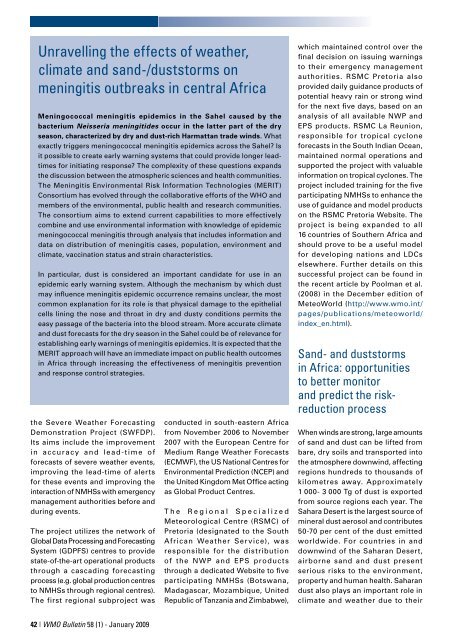Weather, climate and the air we breathe - WMO
Weather, climate and the air we breathe - WMO
Weather, climate and the air we breathe - WMO
You also want an ePaper? Increase the reach of your titles
YUMPU automatically turns print PDFs into web optimized ePapers that Google loves.
Unravelling <strong>the</strong> effects of <strong>we</strong>a<strong>the</strong>r,<br />
<strong>climate</strong> <strong>and</strong> s<strong>and</strong>-/duststorms on<br />
meningitis outbreaks in central Africa<br />
Meningococcal meningitis epidemics in <strong>the</strong> Sahel caused by <strong>the</strong><br />
bacterium Neisseria meningitides occur in <strong>the</strong> latter part of <strong>the</strong> dry<br />
season, characterized by dry <strong>and</strong> dust-rich Harmattan trade winds. What<br />
exactly triggers meningococcal meningitis epidemics across <strong>the</strong> Sahel? Is<br />
it possible to create early warning systems that could provide longer leadtimes<br />
for initiating response? The complexity of <strong>the</strong>se questions exp<strong>and</strong>s<br />
<strong>the</strong> discussion bet<strong>we</strong>en <strong>the</strong> atmospheric sciences <strong>and</strong> health communities.<br />
The Meningitis Environmental Risk Information Technologies (MERIT)<br />
Consortium has evolved through <strong>the</strong> collaborative efforts of <strong>the</strong> WHO <strong>and</strong><br />
members of <strong>the</strong> environmental, public health <strong>and</strong> research communities.<br />
The consortium aims to extend current capabilities to more effectively<br />
combine <strong>and</strong> use environmental information with knowledge of epidemic<br />
meningococcal meningitis through analysis that includes information <strong>and</strong><br />
data on distribution of meningitis cases, population, environment <strong>and</strong><br />
<strong>climate</strong>, vaccination status <strong>and</strong> strain characteristics.<br />
In particular, dust is considered an important c<strong>and</strong>idate for use in an<br />
epidemic early warning system. Although <strong>the</strong> mechanism by which dust<br />
may influence meningitis epidemic occurrence remains unclear, <strong>the</strong> most<br />
common explanation for its role is that physical damage to <strong>the</strong> epi<strong>the</strong>lial<br />
cells lining <strong>the</strong> nose <strong>and</strong> throat in dry <strong>and</strong> dusty conditions permits <strong>the</strong><br />
easy passage of <strong>the</strong> bacteria into <strong>the</strong> blood stream. More accurate <strong>climate</strong><br />
<strong>and</strong> dust forecasts for <strong>the</strong> dry season in <strong>the</strong> Sahel could be of relevance for<br />
establishing early warnings of meningitis epidemics. It is expected that <strong>the</strong><br />
MERIT approach will have an immediate impact on public health outcomes<br />
in Africa through increasing <strong>the</strong> effectiveness of meningitis prevention<br />
<strong>and</strong> response control strategies.<br />
<strong>the</strong> Severe <strong>Wea<strong>the</strong>r</strong> Forecasting<br />
Demonstration Project (SWFDP).<br />
Its aims include <strong>the</strong> improvement<br />
in accuracy <strong>and</strong> lead-time of<br />
forecasts of severe <strong>we</strong>a<strong>the</strong>r events,<br />
improving <strong>the</strong> lead-time of alerts<br />
for <strong>the</strong>se events <strong>and</strong> improving <strong>the</strong><br />
interaction of NMHSs with emergency<br />
management authorities before <strong>and</strong><br />
during events.<br />
The project utilizes <strong>the</strong> network of<br />
Global Data Processing <strong>and</strong> Forecasting<br />
System (GDPFS) centres to provide<br />
state-of-<strong>the</strong>-art operational products<br />
through a cascading forecasting<br />
process (e.g. global production centres<br />
to NMHSs through regional centres).<br />
The first regional subproject was<br />
2 | <strong>WMO</strong> Bulletin 58 (1) - January 2009<br />
conducted in south-eastern Africa<br />
from November 2006 to November<br />
2007 with <strong>the</strong> European Centre for<br />
Medium Range <strong>Wea<strong>the</strong>r</strong> Forecasts<br />
(ECMWF), <strong>the</strong> US National Centres for<br />
Environmental Prediction (NCEP) <strong>and</strong><br />
<strong>the</strong> United Kingdom Met Office acting<br />
as Global Product Centres.<br />
The Regional Specialized<br />
Meteorological Centre (RSMC) of<br />
Pretoria (designated to <strong>the</strong> South<br />
African <strong>Wea<strong>the</strong>r</strong> Service), was<br />
responsible for <strong>the</strong> distribution<br />
of <strong>the</strong> NWP <strong>and</strong> EPS products<br />
through a dedicated Website to five<br />
participating NMHSs (Botswana,<br />
Madagascar, Mozambique, United<br />
Republic of Tanzania <strong>and</strong> Zimbab<strong>we</strong>),<br />
which maintained control over <strong>the</strong><br />
final decision on issuing warnings<br />
to <strong>the</strong>ir emergency management<br />
authorities. RSMC Pretoria also<br />
provided daily guidance products of<br />
potential heavy rain or strong wind<br />
for <strong>the</strong> next five days, based on an<br />
analysis of all available NWP <strong>and</strong><br />
EPS products. RSMC La Reunion,<br />
responsible for tropical cyclone<br />
forecasts in <strong>the</strong> South Indian Ocean,<br />
maintained normal operations <strong>and</strong><br />
supported <strong>the</strong> project with valuable<br />
information on tropical cyclones. The<br />
project included training for <strong>the</strong> five<br />
participating NMHSs to enhance <strong>the</strong><br />
use of guidance <strong>and</strong> model products<br />
on <strong>the</strong> RSMC Pretoria Website. The<br />
project is being exp<strong>and</strong>ed to all<br />
16 countries of Sou<strong>the</strong>rn Africa <strong>and</strong><br />
should prove to be a useful model<br />
for developing nations <strong>and</strong> LDCs<br />
elsewhere. Fur<strong>the</strong>r details on this<br />
successful project can be found in<br />
<strong>the</strong> recent article by Poolman et al.<br />
(2008) in <strong>the</strong> December edition of<br />
MeteoWorld (http://www.wmo.int/<br />
pages/publications/meteoworld/<br />
index_en.html).<br />
S<strong>and</strong>- <strong>and</strong> duststorms<br />
in Africa: opportunities<br />
to better monitor<br />
<strong>and</strong> predict <strong>the</strong> riskreduction<br />
process<br />
When winds are strong, large amounts<br />
of s<strong>and</strong> <strong>and</strong> dust can be lifted from<br />
bare, dry soils <strong>and</strong> transported into<br />
<strong>the</strong> atmosphere downwind, affecting<br />
regions hundreds to thous<strong>and</strong>s of<br />
kilometres away. Approximately<br />
1 000- 3 000 Tg of dust is exported<br />
from source regions each year. The<br />
Sahara Desert is <strong>the</strong> largest source of<br />
mineral dust aerosol <strong>and</strong> contributes<br />
50-70 per cent of <strong>the</strong> dust emitted<br />
worldwide. For countries in <strong>and</strong><br />
downwind of <strong>the</strong> Saharan Desert,<br />
<strong>air</strong>borne s<strong>and</strong> <strong>and</strong> dust present<br />
serious risks to <strong>the</strong> environment,<br />
property <strong>and</strong> human health. Saharan<br />
dust also plays an important role in<br />
<strong>climate</strong> <strong>and</strong> <strong>we</strong>a<strong>the</strong>r due to <strong>the</strong>ir

















